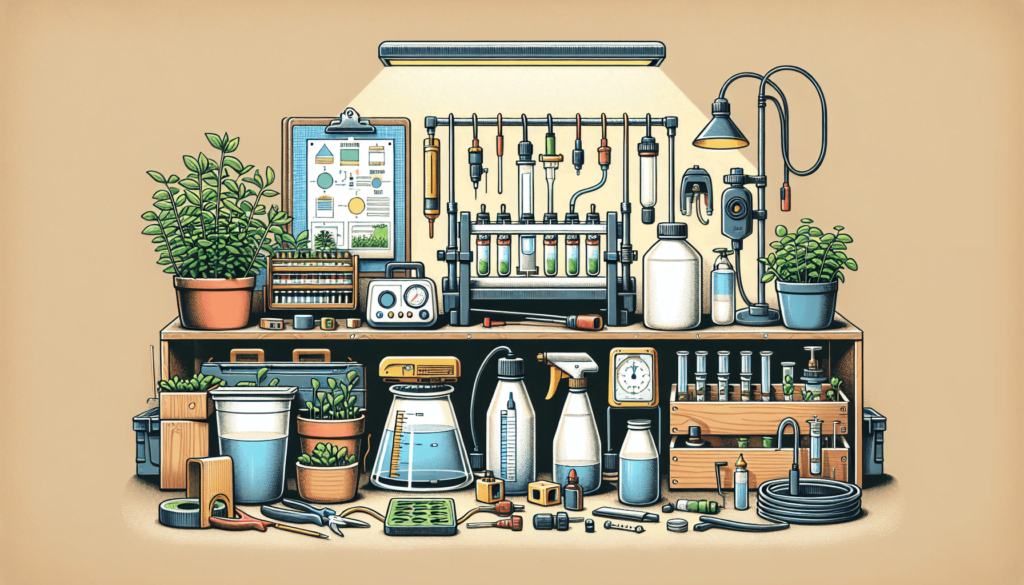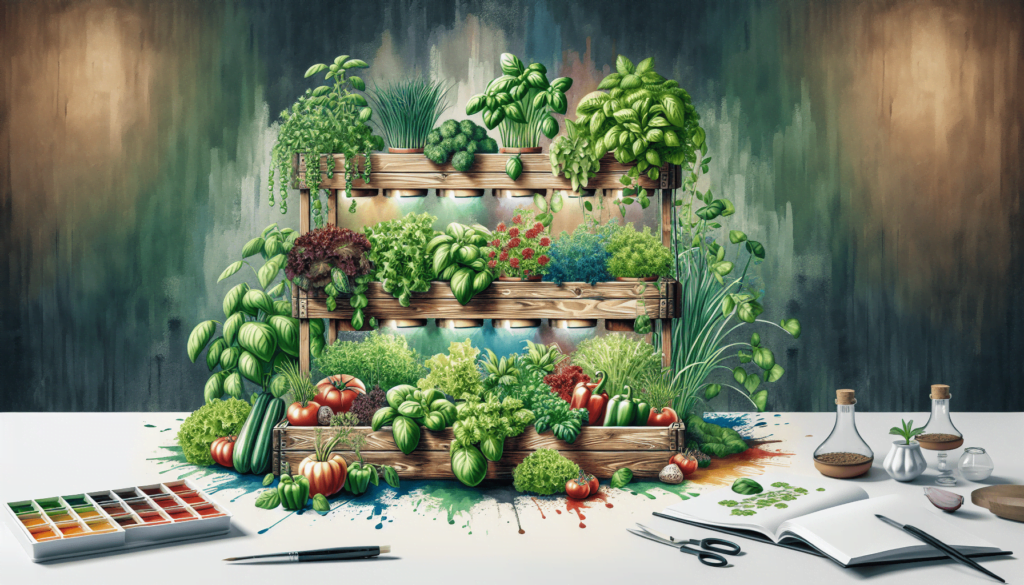In the pursuit of healthy, home-grown crops, we’ve put together a comprehensive guide on how to build a budget-friendly hydroponic system. Understanding that not everyone has sprawling garden spaces or green thumbs, we’ve crafted this guide to make growing your own food accessible for all. This article will help you navigate through the design, construction, and maintenance of an affordable hydroponic system that is efficient, economical, and above all, beginner-friendly. Trust us; home gardening has never been so simple and rewarding!
Understanding Hydroponics
In our journey toward sustainable and effective agriculture practices, we’ve discovered a method that is gaining a lot of attention lately. This method is Hydroponics.
Definition of hydroponics
So, what exactly is hydroponics? Simply put, it is a type of horticulture and a subset of hydroculture, which involves growing plants without soil by using mineral nutrient solutions in a water solvent. This means that we provide the plants directly with the water, nutrients, and light they need, without the need for soil.
Benefits of hydroponics
Why should we use hydroponics? It has many advantages. For starters, it’s a water-saving technique, as hydroponic systems use substantially less water than traditional soil-based gardening. It allows us to have full control over the nutrients our plants receive, as well as the pH levels. This precision leads to greater yields and faster growth, as the plants don’t need to expend energy searching for nutrients in soil. Moreover, since we grow in a controlled environment, we can grow plants year-round, irrespective of the season, and without the usual pests or diseases that come with soil gardening.
Types of hydroponic systems
Now, there are different types of hydroponic systems to choose from. The main ones are: the Wick system, the Deep Water Culture (DWC) system, the Nutrient Film Technique (NFT) system, the Ebb and Flow system, the Aeroponics system, and the Drip system. Each of these systems has its unique functioning method, but the common theme is the direct delivery of nutrient-rich solution to the plants.
Necessary Materials for a Hydroponic System
So, what do we need to set up our hydroponic system? The basic materials are not very complex.
Hydroponic grow medium
Instead of soil, we use an inert grow medium to support the roots of our plants. Options include rockwool, coconut coir, perlite, and clay pebbles.
Reservoir
A reservoir is required to hold our nutrient solution. The size of the reservoir should correspond to the size of our hydroponic system.
Air pump
An air pump, used usually in aquariums, is needed to aerate our nutrient solution and keep our roots from drowning.
Plant nutrients
Instead of taking nutrients from soil, our plants will receive them from a hydroponic nutrient solution, which contains all the primary, secondary, and micronutrients plants need.
Grow lights
If we aren’t growing in a place with plenty of sunlight, we’ll need some grow lights. High-Intensity Discharge (HID) bulbs, fluorescent bulbs, or Light Emitting Diodes (LEDs) all work excellently.

Creating a Budget for Your Hydroponic System
Starting a hydroponic system might seem expensive, but with careful planning, we can keep costs under control.
Consideration of upfront costs
The initial setup, including the hydroponic system, grow lights, fans, etc., may be the largest portion of our expenses. However, these are one-time costs that we should perceive as an investment.
Estimation of ongoing costs
Monthly costs will include water, electricity, nutrients, and replacement of any grow medium. These being considerably lower, it’s still important to factor them into our planning to avoid any surprises.
Searching for cheap alternatives and used materials
There’s no rule saying we must buy every item brand new. Used or second-hand equipment can be just as effective, saving us some money in the process.
Avoidance of unnecessary expenditures
Starting small and gradually expanding can help prevent overspending. It may be tempting to opt for fancier equipment initially, but it’s not necessary for a successful setup.
Choosing the Right Location for Your Hydroponic System
The location of our system can have a huge impact on our overall success.
Factor in Availability of space
We want to ensure enough space not just for our system, but for us to move around comfortably for maintenance.
Need for access to electricity
Our system will need a reliable power source nearby for things like lighting, pumps, and other equipment.
Temperature control
A location where the temperature can be controlled is vital. Some plants prefer cooler conditions, while others need a bit of warmth.
Lighting considerations
While artificial lights can do the job, nothing beats natural sunlight if it’s available.

Building the Hydroponic System
Now, it’s time to put together our system.
Step-by-step guide to assembly
Follow the instructions provided with our chosen hydroponic system for assembling it. As long as we take our time and follow every step as instructed, we should face no issues.
One-off costs vs. ongoing maintenance costs
While there’s an upfront cost to building a system, remember that with proper maintenance, the system should last a long time.
Safety tips when building
Safety should always be a number one priority. Always ensure to follow all safety guidelines to prevent any accidents.
Selecting Plants for Your Hydroponic System
Choosing the right plants will help us maximize our setup.
Choosing plants based on space requirements
Some plants, like large fruiting vegetables, require more space. Others, like lettuces and herbs, are more compact.
Consideration of plant nutrient needs
Different plants have different nutrient needs. It’s important to choose plants with similar needs so they can all thrive in the same nutrient solution.
Selection of plants based on light requirements
Again, plants vary in their light needs. We will want to match our plants to the amount of light we can provide.
Maintaining Your Hydroponic System
Regular maintenance is essential for a successful hydroponic system.
Weekly maintenance tasks
This includes tasks like checking the pH and nutrient levels and adjusting as necessary.
Monthly maintenance tasks
At least once a month, we want to flush our system and replace the nutrient solution entirely.
Identifying and treating common problems in hydroponic systems
Be on the lookout for signs of nutrient deficiencies or disease, and take action promptly if you spot anything worrying.
Routine check for pH and nutrient levels
Regular monitoring of the nutrient solution is vital to ensure our plants are getting the right nutrients.
Harvesting and Replanting
With diligent care and maintenance, our plants will grow rapidly, and soon it will be time to harvest.
Knowing when to harvest
The right time to harvest varies with each plant species. So we need to refer to plant-specific guidelines to ensure we’re harvesting at the optimal time.
How to harvest
We always want to use clean, sharp tools to harvest. This will minimize damage to the plant and prevent the spread of disease.
Replanting process in a hydroponic system
After a successful harvest, we can start the cycle again by replanting. Just be sure to properly clean the system before replanting to prevent any disease carryover.
Maximizing the Productivity of Your Hydroponic System
To get the most out of our system, we must keep a watchful eye on our plants and continuously tweak conditions to suit them best.
Regular monitoring of plant growth
By checking on our plants daily, we can spot any problems before they escalate.
The importance of optimizing nutrient solution
Research and experience will help us fine-tune the nutrient solution and pH levels for each crop, leading to higher yields.
Scaling up: when and how
If things are going well, we might consider scaling up. This should be a gradual process, giving us time to adapt to each new stage without being overwhelmed.
Turning Your Hydroponic System into a Sustainable Business
It’s possible to turn this hobby into a profitable venture.
Understanding the market
Research is key here. Knowing who our customers will be, what they want, and when they want it will help us plan our crops accordingly.
Calculating production costs
By tracking our costs diligently, we can price our products accurately to ensure profitability.
Pricing your products
We want to set a price that is not only competitive but also covers our costs and gives us a reasonable profit margin.
Marketing your hydroponically grown products
Clever marketing will help us reach our target audience. Highlighting the advantages of hydroponic gardening such as its eco-friendliness can make our products more appealing.
In conclusion, building a budget-friendly hydroponic system can be a rewarding activity. Not only can it provide us with fresh produce, but it can also possibly develop into a sustainable business. All we need is a little patience, a little creativity, and a lot of love for growth.
Forum
Got something to share or a question to ask? Jump in and start a conversation! Whether it’s tips, advice, or just sharing your experiences, we’d love to hear from you. Don’t be shy—your input could inspire or help someone else!- This forum has 1 topic, and was last updated 10 months, 1 week ago by .
- Topic
- Voices
- Last Post
- You must be logged in to create new topics.


